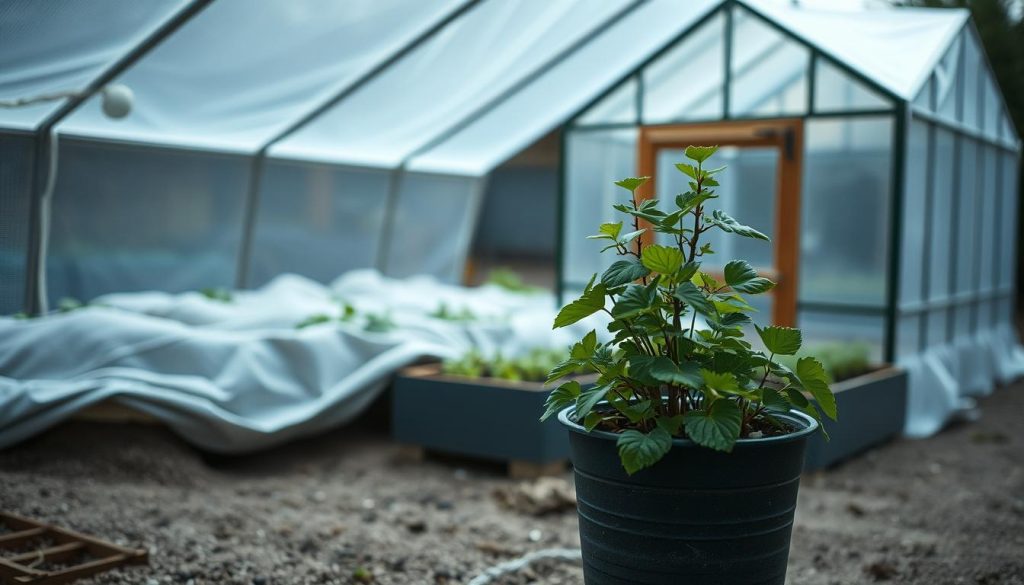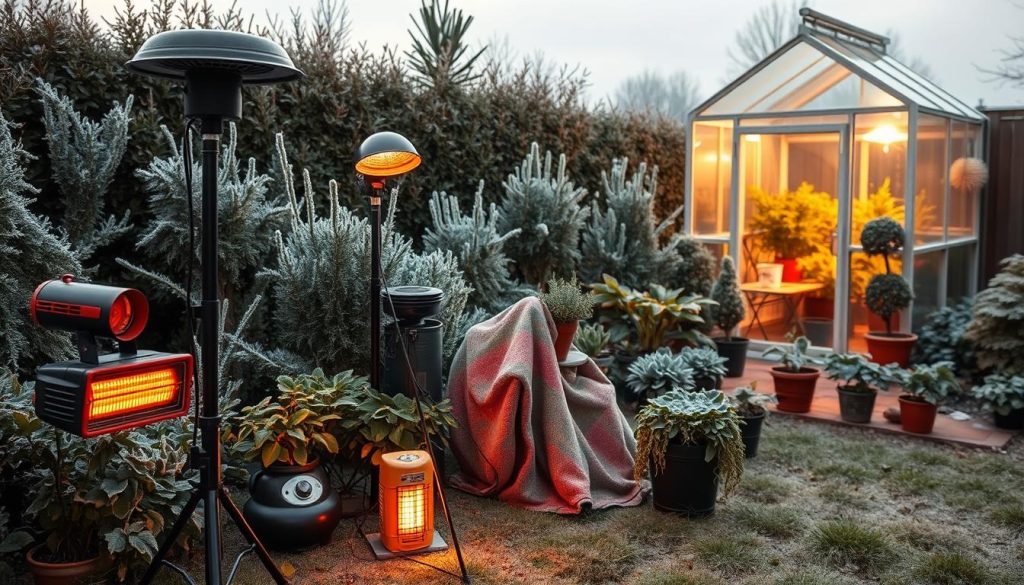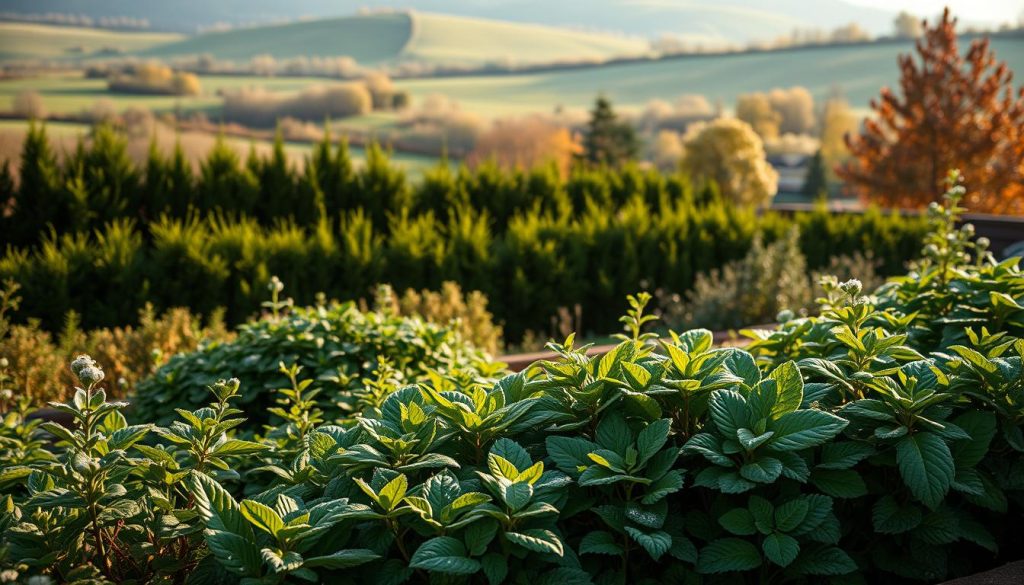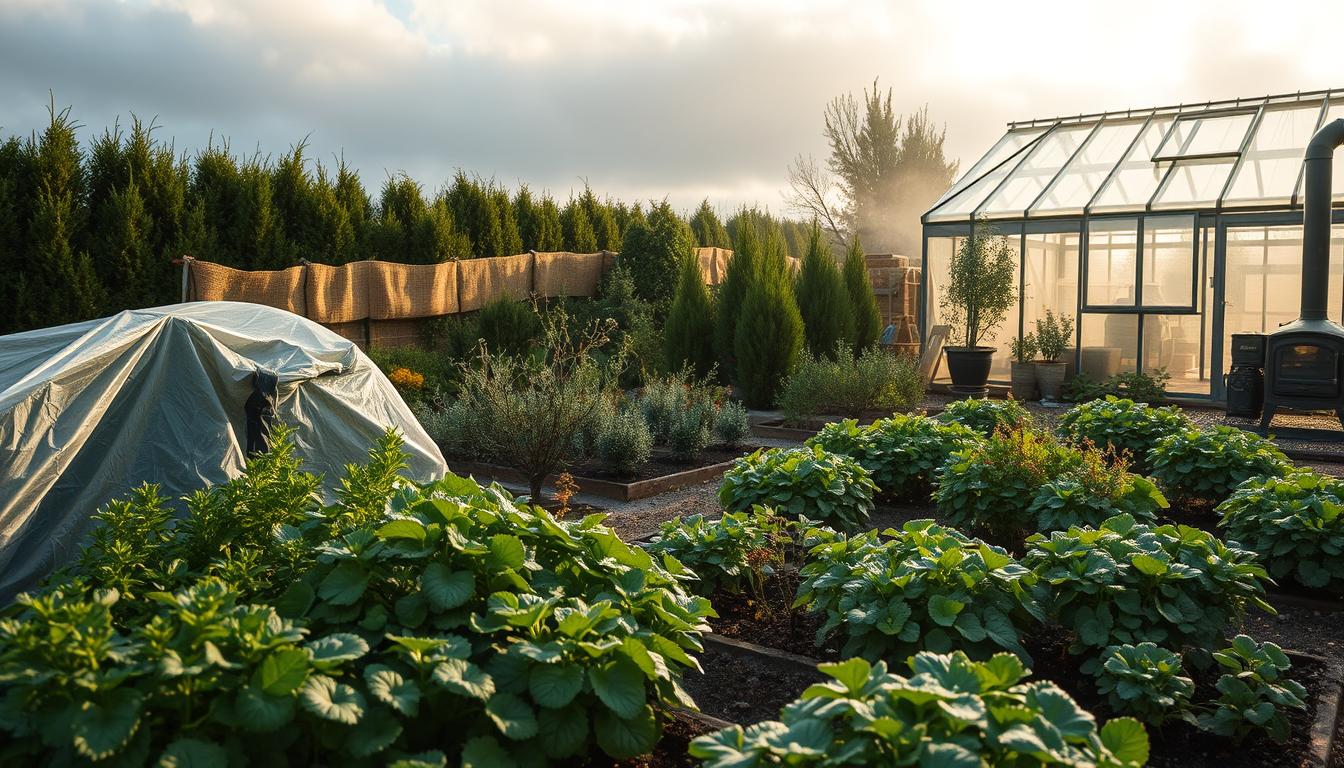When the weather forecast shows a sudden freeze, it’s a gardener’s worst nightmare. After months of care, a single cold night can destroy your plants. But, you can protect your garden from frost.
Years of gardening have taught me the importance of being ready for cold weather. Whether it’s veggies, flowers, or young trees, protecting them from frost is key.
This guide combines my experience with horticultural science. You’ll learn simple and advanced ways to save your plants from frost.
By the end of this, you’ll be ready to face cold weather with confidence. Let’s dive into keeping your garden safe from frost!
Understanding Frost and Its Impact on Gardens
It’s important to know how frost forms to protect your garden. Frost happens when the air temperature drops below freezing. This causes moisture in the air to freeze on surfaces. If your garden isn’t ready, frost can damage or kill plants overnight.
Types of Frost and Their Formation
Not all frost is the same. Knowing the different types helps you defend your garden:
- Radiation frost – Forms on clear, still nights when heat radiates away from the earth’s surface. This is the most common type in home gardens.
- Advection frost – Occurs when cold air masses move into an area, bringing freezing temperatures regardless of cloud cover.
- Hoar frost – Creates those beautiful white crystals on surfaces when water vapor freezes without becoming liquid first.
- Black frost – The most dangerous type, occurring without visible ice formation but causing plant tissues to freeze and turn black.
How Frost Damages Plants at the Cellular Level
Frost damage starts at a tiny level. When it gets cold, ice crystals form inside plant cells. These crystals expand, breaking cell walls and membranes.
After cell damage, plants can’t move water and nutrients. This is why frost-damaged plants look wilted, blackened, or water-soaked when they thaw. The damage’s severity depends on how fast temperatures drop and how long they stay cold.
Identifying Your Garden’s Frost-Prone Areas
Every garden has areas that are more prone to frost. Cold air settles in low spots, creating “frost pockets.” These spots are colder than other areas.
Map your garden’s frost patterns by noting where frost hits first and lasts longest. Areas near buildings, rocks, or water stay warmer. Open spots cool down faster. Knowing these patterns helps you target your cold weather precautions.
Things that make frost worse include:
- Elevation changes across your property
- Proximity to buildings or walls
- Exposure to prevailing winds
- Presence of overhead tree canopy
- Soil type and moisture content
When to Implement Frost Protection Measures
Timing is everything when it comes to protecting your garden from frost. Waiting until frost appears on your lawn is often too late. Knowing when to act is key to keeping your plants safe.

Reading Weather Forecasts Like a Pro
Weather forecasts hold clues about potential frost. Look beyond the temperature and watch for these signs:
- Dew point temperatures approaching or below freezing
- Clear night skies that allow heat to escape rapidly
- Wind speeds below 5 mph, which allow cold air to settle
- Temperature inversions, where ground-level air becomes colder than air above
- Relative humidity dropping below 50%, indicating less insulating moisture in the air
Many gardeners use weather apps. But frost alert services offer more specific warnings. They use local data that general forecasts might miss.
Recognizing High-Risk Frost Periods in Your Region
Frost patterns differ across U.S. climate zones. Northeastern gardeners face longer frost seasons. Midwestern growers deal with big temperature swings. Southern regions have shorter but unexpected frost events.
Keep track of historical frost data for your area. The USDA’s weather database and local extension offices have records. These records show patterns unique to your area, helping you know when to act.
Creating a Seasonal Frost Protection Calendar
A frost protection calendar is your guide. Start with your area’s average last spring and first fall frost dates. Then mark the vulnerable growth stages for each plant in your garden.
Seedlings, new transplants, and plants in bloom need extra care. Regular forecast checks during these times are crucial. Set reminders 48 hours before frost to prepare.
Make a simple decision tree for protection techniques based on forecasted temperatures. For example, light frosts might need just coverings. Hard freezes below 28°F require more extensive protection.
Essential Frost Protection Techniques for Home Gardens
Protecting your plants from frost damage is easy with a few key strategies. These methods are affordable and effective. They help keep your garden safe when the weather gets cold.
Temporary Coverings: Blankets, Sheets, and Row Covers
Temporary coverings are your garden’s first defense against frost. They trap warm air, keeping plants safe from frost damage.
Use old bedsheets, blankets, or burlap to cover large areas. For a more dedicated approach, try commercial row covers. These let light and moisture in while keeping plants warm. Make sure to cover plants before sunset and secure the edges to keep the warmth in.
Take off the covers by mid-morning to avoid overheating. For tall plants, use frames to keep the covering from damaging them.
| Covering Material | Temperature Protection | Best For | Advantages | Disadvantages |
|---|---|---|---|---|
| Bed Sheets | 2-4°F | Large garden areas | Readily available, inexpensive | Can become heavy when wet |
| Floating Row Covers | 4-8°F | Vegetable rows | Allows light and water through | More expensive, tears easily |
| Frost Cloth | 6-10°F | Sensitive plants | Specialized protection, reusable | Higher initial cost |
| Plastic Sheeting | 3-5°F | Temporary protection | Creates greenhouse effect | Must be removed promptly in sun |
Strategic Mulching for Ground Insulation
Mulching keeps soil warm by preventing temperature drops. Use 2-4 inches of organic mulch like straw or bark chips. This creates a warm layer around your plants.
Apply mulch after the first frost to keep soil warm. It’s great for root crops and perennials. Make sure to pull mulch away from stems to avoid rot.
Container Plant Protection Strategies
Potted plants are more vulnerable to frost. Use specific strategies to protect them.
Moving Plants to Protected Locations
Move potted plants to warmer spots like under eaves or porches. These areas stay warmer than open spaces. Grouping plants together helps retain heat.
Insulating Container Sides
Wrap container sides with bubble wrap or blankets to protect roots. Focus on the root zone, as it’s less cold-hardy. Elevate containers to keep them off cold surfaces.
Advanced Insulation Methods for Valuable Plants
There’s more to protecting your garden than just using basic coverings. For your most precious plants, there are specialized frost protection strategies. These methods offer better temperature control during frost, making them a good investment for your garden’s most valuable plants.
Specialized Frost Cloths and Materials
Commercial frost protection products are better than household items. Floating row covers, for example, can keep plants safe down to 28°F. They let light through and prevent moisture buildup that can harm plants.
Thermal blankets are made for plant protection. They can keep temperatures up to 8°F warmer than outside air. Unlike regular blankets, they won’t get heavy and soggy in the rain.
Professional-grade frost cloths are made to last. They resist sunlight damage and can be used for many seasons if stored right.

Creating Effective Microclimate Shelters
Creating semi-permanent shelters can extend your growing season. Wall-of-water devices act like mini-greenhouses. They keep plants warm by absorbing and releasing heat.
Cloche structures use plastic sheeting over PVC frames. They create warm zones in your garden. Make sure these shelters can breathe on warm days to avoid overheating.
Double-Layer Protection Systems
The best frost protection uses multiple layers. It’s like double-pane windows, where air between layers insulates well.
Combining Physical Barriers with Air Gaps
Using frost cloths above plants adds an extra layer of insulation. This method prevents cold from transferring directly to plants. For extra protection, use a lightweight row cover under a heavier blanket.
Structural Supports for Coverings
Frame systems keep coverings off plants. Use garden hoops, tomato cages, or PVC pipes for support. For bigger areas, metal hoops are a good choice.
Make sure supports are tall and strong. They should handle wind and plant growth. Use bricks, landscape pins, or clips to keep coverings in place at night.
Harnessing Water for Frost Protection
Water and frost might seem like enemies, but water can protect your garden. Its thermal properties make it a key tool against frost. This can surprise even seasoned gardeners.
Strategic Soil Moisture Management
Moist soil is like a thermal battery for your garden. It stores heat during the day and releases it at night. This can warm your plants by several degrees.
Water your garden 1-2 days before frost. Water in the morning so soil can absorb heat. Avoid evening watering to prevent cooling.
Soil should be moist but not too wet. Too much water can conduct cold and harm roots, more so in clay gardens.
Overhead Sprinkler Systems for Frost Prevention
Water sprinklers protect plants through a scientific principle. Freezing water releases heat, keeping plant tissues warm. This prevents damage even as ice forms.
Start sprinklers before freezing and keep them running until ice melts. Use 0.1-0.15 inches of water per hour for full coverage.
The Science Behind Ice Encasement Protection
A layer of ice can protect plants, not harm them. Ice keeps tissue temperature at 32°F, preventing damage to many plants.
This works because ice insulates against further cooling. Tissues stay at freezing point, not dropping to colder air temperatures.
When to Use This Method (And When to Avoid It)
Water sprinkling is best for low-growing crops and small trees. It works well during radiation frosts.
Avoid it for plants with brittle branches. Also, skip it during advection frosts with winds over 10 mph. Water will evaporate too quickly.
Keep sprinkling until temperatures rise and ice melts. Stopping can cause rapid cooling and damage.
Heat Sources and Temperature Modification Techniques
Gardeners can fight frost by using heat sources to change local temperatures. Covering plants is a start, but adding heat can be key during cold snaps. You can use simple or advanced methods, from DIY to commercial systems.
Passive Heat Collection Using Thermal Mass
Thermal mass elements quietly protect your garden. They soak up solar energy during the day and release it at night. This natural process creates a warm spot around plants.
Stone pathways in your garden do more than just provide a path. They collect heat from the sun. Dark stones absorb more heat. Water containers near plants also release heat at night.
Decorative stones or water features can add beauty and warmth to your garden. Even dark mulch helps retain heat and improves soil.
Small-Scale Heating Options for Home Gardens

When passive methods aren’t enough, active heating can help. Electric cables under plants keep the soil warm. They’re great for raised beds or containers.
Using incandescent bulbs under covers is another way to keep plants warm. For small areas, candles or patio heaters can offer targeted protection.
Commercial Orchard Heating Techniques Adapted for Gardens
Professional growers have advanced frost protection methods. Home gardeners can use these techniques on a smaller scale. Modern orchard heating is efficient and can be adapted for home use.
| Commercial Method | Home Garden Adaptation | Best For | Approximate Cost |
|---|---|---|---|
| Smudge pots | Small outdoor-rated heaters | Fruit trees, valuable shrubs | $40-100 per unit |
| Propane orchard heaters | Patio heaters | Larger garden areas | $150-300 |
| Wind machines | Oscillating outdoor fans | Areas with temperature inversions | $80-200 |
| Heated irrigation | Warm water drip systems | Root zone protection | $50-150 plus water heating |
Safe Use of Heat Sources
Always prioritize safety when using heat sources. Make sure there’s good air flow with fuel heaters to avoid carbon monoxide. Keep flammable things away from heat and never leave a flame alone.
For electric solutions, use only outdoor-safe gear and keep it dry. Use GFCIs for safety. Active heating is best for protecting valuable plants, not the whole garden.
Air Circulation Strategies to Combat Frost Damage
Using air circulation to fight frost is a smart move. When it gets cold, how air moves around your garden matters a lot. Good air flow stops cold air from settling on your plants and can warm them up a bit during frost.
Understanding Cold Air Drainage Patterns
Cold air flows downhill, just like water. On clear, calm nights, it settles in low spots. This makes frost pockets where your plants are most at risk.
To spot where cold air collects, look where frost lingers longest. You can also use smoke to see how air moves. Release smoke and watch it flow to see where cold air goes.
Even small changes in height can make a big difference in temperature. Check temperatures at different spots in your garden. This helps you understand where cold spots are and how to protect them.
Small-Scale Fan Systems for Critical Plants
Fans can help keep plants safe from frost. They mix cold air with warmer air above. This keeps plants from getting too cold.
For small gardens, use fans on low speed. Place them so they blow across your plants, not directly at them. This keeps air moving gently. Battery or solar fans are good for places without power.
Turn on fans when it starts to get cold. Keep them running until it warms up again. Some people use fans with thermostats to turn them on automatically.
| Fan Type | Coverage Area | Power Requirements | Best Applications | Approximate Cost |
|---|---|---|---|---|
| Oscillating Floor Fan | 100-200 sq ft | Standard outlet (40-60W) | Patios, small gardens | $30-$50 |
| Box Fan | 150-250 sq ft | Standard outlet (50-80W) | Raised beds, container gardens | $20-$40 |
| Outdoor Rated Circulation Fan | 300-500 sq ft | Standard outlet (80-120W) | Medium garden areas | $70-$150 |
| Solar-Powered Fan | 50-150 sq ft | Solar panel (battery backup) | Remote garden areas | $100-$200 |
Natural Windbreak Planning and Implementation
Windbreaks can change how air moves, helping protect your garden. They offer long-term benefits and make your garden look better. Place them right to block cold air from your plants.
Evergreen plants are great for windbreaks. Put them on the north and northwest sides to block cold winds. Make sure they let some air through to prevent cold air from getting trapped.
For quick fixes, use burlap, fabric, or straw bales. Put them 4-5 feet from your plants. This creates a warm spot without blocking air that keeps frost away.
Using air circulation with windbreaks and fans is key to fighting frost. It’s all about understanding and managing air in your garden. This way, you can keep your plants safe even when it’s very cold.
Long-Term Garden Planning for Frost Resilience
To make a frost-resilient garden, you need to plan carefully. Emergency measures help, but designing your garden to resist frost is better. With good planning, your garden can handle frost and grow longer than usual.
Strategic Site Selection for New Gardens
Choosing the right spot for your garden is key. The right location offers natural protection that other methods can’t. Look at these important factors when picking a site:
- Elevation changes – cold air flows downhill and settles in low spots
- Southern or eastern exposures receive more warming sunlight
- Proximity to buildings that radiate stored heat
- Nearby bodies of water that moderate temperature fluctuations
- Existing trees and structures that block cold winds
Watch potential garden sites in different seasons and times. See where frost hits first and stays longest. This helps you pick the best spot.

Landscape Design Elements That Minimize Frost Risk
After picking your site, add design elements that fight frost. Raised beds warm up faster and drain better, protecting roots. Stone walls, paths, and water features hold heat and release it at night, creating warm spots.
Placing trees and shrubs wisely can block cold winds and let morning sun in. Make windbreaks on the north and west sides to block cold winds.
Building Permanent Protective Structures
For serious frost protection, permanent structures are the best. They cost more upfront but save effort and provide steady protection.
Cold Frames and Cloches
Cold frames use solar heat to warm plants. They’re great for starting seeds or protecting small plants. Use recycled windows or clear plastic over a wooden frame. Cloches, like plastic bottles, protect individual plants.
Hoop Houses and Greenhouses
Hoop houses are affordable for bigger areas. They use PVC pipes and plastic to trap heat. Greenhouses with heating can grow plants all year, even in cold climates.
Design structures with vents to avoid too much heat. Automatic vents and roll-up sides make them easier to manage. Place them to get winter sun and have access to water and electricity.
Selecting Frost-Resistant Plant Varieties for U.S. Regions
Choosing plants that can handle cold temperatures is the best way to protect your garden from frost. This method works with nature, not against it. It makes your garden more resilient during cold weather.
Cold-Hardy Vegetables and Herbs by Hardiness Zone
In zones 3-4, ‘Siberian’ kale, ‘Waltham’ Brussels sprouts, and ‘Winterbor’ collards are great. They can handle very cold temperatures.
For zones 5-6, ‘Winter Density’ lettuce, ‘Giant Winter’ spinach, and ‘Vates’ cabbage are good choices. They keep producing even when it’s very cold. Herbs like sage, thyme, and winter savory also stay flavorful in the cold.
In zones 7-8, ‘Purple Sprouting’ broccoli, ‘Bright Lights’ Swiss chard, and ‘Scarlet Nantes’ carrots are excellent. They get sweeter after a light frost.
Frost-Tolerant Flowers and Ornamentals
Pansies, like ‘Cool Wave’ and ‘Ice Bloom’, bloom through light frosts. They can even recover from harder freezes.
Perennials like hellebores, sedum, and yarrow stay strong through winter. Ornamental grasses like ‘Karl Foerster’ feather reed grass add interest even when they’re dormant. Native plants usually do better in frost than exotic ones.
Understanding Microclimates for Strategic Plant Placement
Temperature can vary a lot in one garden. South-facing walls get warm during the day and cool at night. This makes them up to 10°F warmer than other areas.
Low-lying areas collect cold air and get colder than other spots. They’re best for the toughest plants. Knowing about these microclimates helps you place plants where they’ll do best.
Regional Considerations from Northeast to Southwest
In the Northeast, choose plants that mature quickly and can be harvested before it gets too cold. The Midwest needs plants that can handle strong winds and cold.
The Southeast has plants that can handle quick temperature changes. In the Southwest, plants need to handle big temperature swings.
By picking the right plants for your area, your garden will be more resilient. This saves time and resources. It also means healthier, more productive plants.
My Tried-and-True Approach to Garden Frost Protection
After 15 years of gardening in Zone 5, I’ve found a solid way to protect my garden from frost. I prepare early, watch the weather closely, and act fast when frost is coming.
I sort my plants into three groups. My “high-priority” plants, like expensive perennials and heirloom veggies, get the best care. They’re covered with frost cloth and sometimes extra heat. “Medium-priority” plants get basic covers like old sheets or row covers. And “low-priority” plants, which are frost-hardy or easy to replace, look out for themselves.
When the forecast says it will be cold, I act quickly. Frost can hit even when it’s just above freezing. My garage is set up as a “frost protection station” with everything ready to go.
Creating microclimates is a key frost protection technique I’ve learned. I use mulch, water-filled containers, and barriers to protect my plants. This trick has let me grow plants for almost a month longer in spring and fall.
Yes, I’ve lost plants to frost, and it’s always tough. But those losses have made me a better gardener. Even experts can’t save every plant. Losing some is part of learning and getting better.

